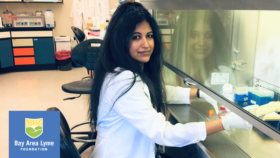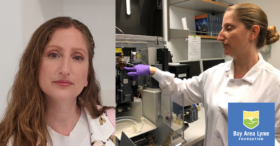FOR IMMEDIATE RELEASE
Bay Area Lyme Foundation Announces National Winner of the 2025 Emerging Leader Award to Develop a Much-Needed Rapid, Low-Cost, Easy-to-Use Lyme Disease Test
Winner Chao Wang of Arizona State University will receive $150,000 to evaluate a unique diagnostic that uses gold nanoparticles and has been proven in other infectious diseases
PORTOLA VALLEY, Calif., June 12, 2025—Bay Area Lyme Foundation, a leading sponsor of Lyme disease research in the US, has given its 2025 Emerging Leader Award (ELA) to Chao Wang, PhD, associate professor in the School of Electrical, Computer and Energy Engineering at Arizona State University, faculty with ASU’s Biodesign Institute® and an expert in nanotechnology and biosensors. Wang will receive $150,000 to support his work to develop a much-needed rapid, low-cost, easy-to-use test, called Nano2RED-LD, for Lyme disease. The test aims to deliver results in as few as 30 minutes when a patient who may have Lyme disease first sees a doctor.
There is an immense need for better Lyme disease tests. Today’s standard-of-care tests miss too many cases at all stages of Lyme disease, including as many as 70% of early Lyme cases.
“With Lyme disease cases rising steadily across the U.S., the need for accurate and timely diagnostic tools has never been greater,” said Katariina Tuovinen, research grant director, Bay Area Lyme Foundation. “Dr. Wang’s pioneering work epitomizes the essence of this award as it applies innovation from other infectious diseases in an effort to enhance outcomes for patients affected by Lyme disease.”
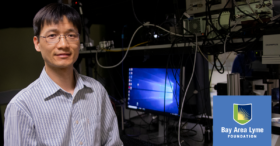
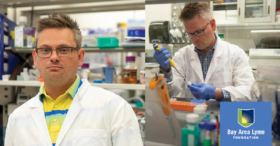



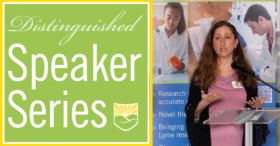
 “I want to leave you with hope. I think we’re going to be unstoppable because I think that these are solvable problems. These are answerable questions. I think that there are already a lot of existing tools in immunology that just need to be brought into the fight, and we can change this.”
“I want to leave you with hope. I think we’re going to be unstoppable because I think that these are solvable problems. These are answerable questions. I think that there are already a lot of existing tools in immunology that just need to be brought into the fight, and we can change this.” 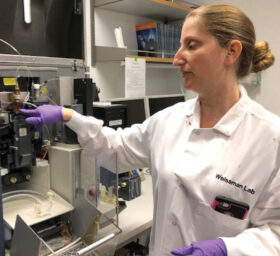 Any respectable pathogen that can establish a persistent infection needs to figure out your immune system to the point that it can evade it. The fact that it has persisted means that it was able to evade your immune clearance. And so, I got to that from a very interesting direction working on immune regulation, trying to understand these brakes on the immune response and how they impact the response to infection. The immune system has the power to kill you and obviously, nobody has any incentive for that to happen. So, there are a lot of mechanisms in place to put brakes on the immune system and reign it in. One of the huge developments in cancer over the last two decades has been reevaluating the question: can we take those brakes off? So in my postdoc, I was studying a particular checkpoint where this was turning into an exciting immuno-oncology target, and I said, ‘I want to look at how this checkpoint is used in infection.’ I realized that this checkpoint was being used to help you survive an acute infection, but created a vulnerability for pathogens to evade immune clearance and establish chronic infection much like it allows cancer cells to evade immune clearance. In an amazing collaboration with Irv Weissman, Balyn Zaro, and Jenifer Coburn we realized that the bacteria that cause Lyme disease manipulate this brake and that’s how I became fascinated with Lyme. But I also became concerned about turning off this brake in cancer patients because I was concerned about what would happen if you used this on cancer patients during an active infection. Indeed, the
Any respectable pathogen that can establish a persistent infection needs to figure out your immune system to the point that it can evade it. The fact that it has persisted means that it was able to evade your immune clearance. And so, I got to that from a very interesting direction working on immune regulation, trying to understand these brakes on the immune response and how they impact the response to infection. The immune system has the power to kill you and obviously, nobody has any incentive for that to happen. So, there are a lot of mechanisms in place to put brakes on the immune system and reign it in. One of the huge developments in cancer over the last two decades has been reevaluating the question: can we take those brakes off? So in my postdoc, I was studying a particular checkpoint where this was turning into an exciting immuno-oncology target, and I said, ‘I want to look at how this checkpoint is used in infection.’ I realized that this checkpoint was being used to help you survive an acute infection, but created a vulnerability for pathogens to evade immune clearance and establish chronic infection much like it allows cancer cells to evade immune clearance. In an amazing collaboration with Irv Weissman, Balyn Zaro, and Jenifer Coburn we realized that the bacteria that cause Lyme disease manipulate this brake and that’s how I became fascinated with Lyme. But I also became concerned about turning off this brake in cancer patients because I was concerned about what would happen if you used this on cancer patients during an active infection. Indeed, the 
 Lyme Disease Biobank established a key partnership with the nonprofit
Lyme Disease Biobank established a key partnership with the nonprofit  “Although it is an emotional and difficult idea for anyone to plan to donate parts of their body to science after they have died, we believe that this decision is an important way for Lyme patients to change the course of Lyme disease research. Having access to tissues from the brain, heart, joints, and central nervous system of Lyme patients allows researchers to prove unequivocally that Lyme is present in tissue and contributes to patient suffering,” explains
“Although it is an emotional and difficult idea for anyone to plan to donate parts of their body to science after they have died, we believe that this decision is an important way for Lyme patients to change the course of Lyme disease research. Having access to tissues from the brain, heart, joints, and central nervous system of Lyme patients allows researchers to prove unequivocally that Lyme is present in tissue and contributes to patient suffering,” explains 
 Charlotte Mao:
Charlotte Mao: